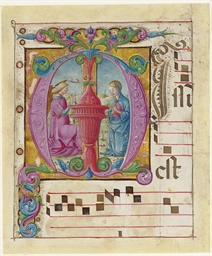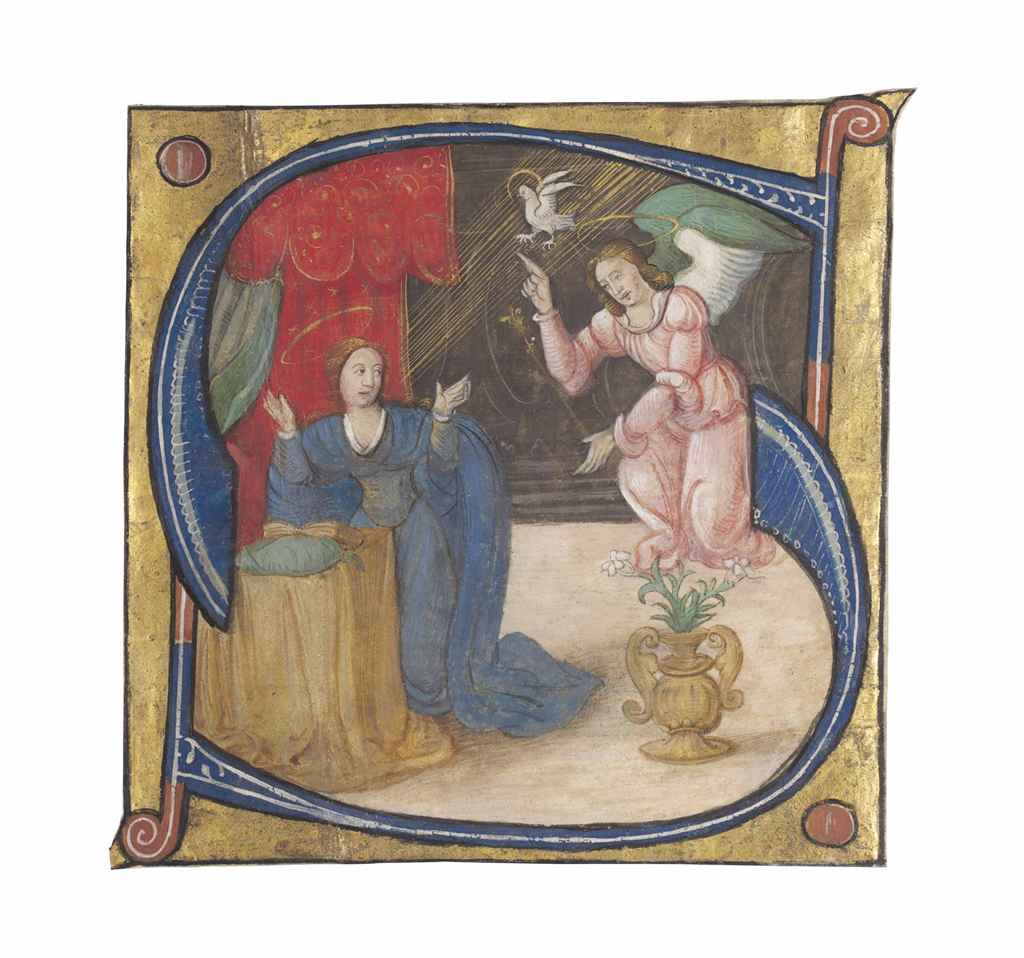THE ANNUNCIATIONin a very large historiated initial ‘R’ cut from a Renaissance illuminated manuscript choirbook [Paris, late 15th or early 16th century] a vellum cutting, c.205×210mm, apparently a composite of one main cutting plus two narrow strips of border from the same manuscript applied to the right and lower sides to form a full border, the initial ‘R’, doubtless for the introit ‘Rorate caeli desuper’ (Drop down dew, heavens, from above), sung in Advent and on the Feast of the Annunciation) depicting Gabriel approaching from the left, the Dove flying down from God in heaven, the Virgin kneeling at a prie-dieu, apparently set on a Renaissance terrace with a marble balustrade beyond which is a fine landscape with a river and town; stuck down to pasteboard, so the text on the reverse is not legible, but with very slight show-through of red staves and musical notation; with a few trivial blemishes, but overall in excellent condition The quality of the illumination is very high, and attributable to Jean Pichore active in Paris c.1490–1521, or else an associate working in a very closely related style. Pichore is reasonably well documented: between 1501 and 1503 he contributed to a De civitate dei for Cardinal d’Amboise (BnF, ms Lat. 2070), and in 1517/18 he painted a Chants royaux for Louise de Savoie (BnF, ms Fr. 145; Avril & Reynaud, 1993, no. 156; discussed in greater detail by Orth, 2015). He is described in documents as ‘enlumineur et historieur’, and lived in Paris, even when undertaking commissions for patrons in other cities. He is also documented as the designer/engraver of images in early 16th-century Parisan printed books (on which see especially Zöhl, 2004). The style of illumination straddles the late Gothic and early Renaissance, for while the figures and the setting of the scene itself is almost entirely Renaissance, in its architectural features such as the ballustrade, the carved giltwood throne, and the use of multi-coloured marbles, yet the coloured ivyleaf ornament that surrounds the initial had become popular in France at least a half-century earlier. As usual for Pichore, the faces and hands of the figures are very pale, modelled only in grey and with a subtle blush of pink to the cheeks, which gives them an appearance very reminiscent of painted enamels, a medium which became popular at the end of the 15th century (see the chapter ‘Les Émaux peints’ in the exhibition catalogue France 1500: entre Moyen Age et Renaissance, ed. by E. Taburet-Delahaye (Paris, 2010), pp. 257–67, especially the images on 258 and 265). The manuscript from which this cutting comes has not been identified, but it must have been a huge choirbook commissioned by an aristocratic or royal patron. It may be significant that its very large dimensions, and the manner in which the initial is surrounded on all sides by pieces of cut border, are closely comparable with a series of cuttings from one or more royal choirbooks commissioned by King Louis XII and his second wife, Anne of Brittany, between 1499 (when they married) and 1514 (when she died). Le Roux de Lincy recorded in 1860 (Vie de la reine Anne de Bretagne, II, p. 86), the manuscript had been cut up at least 20 years earlier. A full leaf survives (Wellesley College, MS 6), showing that the overall size was c.660×500mm. Such a commission would doubtless have comprised winter and summer Graduals, and winter and summer Antiphonals, potentially each in multiple volumes. Such a large commission would typically have involved more than one artist, and so differences in style between the present cutting and other cuttings from the choirbooks of King Louis and Anne are to be expected. While we cannot be sure that the present cutting comes from this set of royal choirbooks, circumstantial evidence makes it a plausible possibility. For the record, therefore, we provide below a list of cuttings previously attributed to the series: From the collection of Ambroise Firmin-Didot-(d.1876); his s
THE ANNUNCIATIONin a very large historiated initial ‘R’ cut from a Renaissance illuminated manuscript choirbook [Paris, late 15th or early 16th century] a vellum cutting, c.205×210mm, apparently a composite of one main cutting plus two narrow strips of border from the same manuscript applied to the right and lower sides to form a full border, the initial ‘R’, doubtless for the introit ‘Rorate caeli desuper’ (Drop down dew, heavens, from above), sung in Advent and on the Feast of the Annunciation) depicting Gabriel approaching from the left, the Dove flying down from God in heaven, the Virgin kneeling at a prie-dieu, apparently set on a Renaissance terrace with a marble balustrade beyond which is a fine landscape with a river and town; stuck down to pasteboard, so the text on the reverse is not legible, but with very slight show-through of red staves and musical notation; with a few trivial blemishes, but overall in excellent condition The quality of the illumination is very high, and attributable to Jean Pichore active in Paris c.1490–1521, or else an associate working in a very closely related style. Pichore is reasonably well documented: between 1501 and 1503 he contributed to a De civitate dei for Cardinal d’Amboise (BnF, ms Lat. 2070), and in 1517/18 he painted a Chants royaux for Louise de Savoie (BnF, ms Fr. 145; Avril & Reynaud, 1993, no. 156; discussed in greater detail by Orth, 2015). He is described in documents as ‘enlumineur et historieur’, and lived in Paris, even when undertaking commissions for patrons in other cities. He is also documented as the designer/engraver of images in early 16th-century Parisan printed books (on which see especially Zöhl, 2004). The style of illumination straddles the late Gothic and early Renaissance, for while the figures and the setting of the scene itself is almost entirely Renaissance, in its architectural features such as the ballustrade, the carved giltwood throne, and the use of multi-coloured marbles, yet the coloured ivyleaf ornament that surrounds the initial had become popular in France at least a half-century earlier. As usual for Pichore, the faces and hands of the figures are very pale, modelled only in grey and with a subtle blush of pink to the cheeks, which gives them an appearance very reminiscent of painted enamels, a medium which became popular at the end of the 15th century (see the chapter ‘Les Émaux peints’ in the exhibition catalogue France 1500: entre Moyen Age et Renaissance, ed. by E. Taburet-Delahaye (Paris, 2010), pp. 257–67, especially the images on 258 and 265). The manuscript from which this cutting comes has not been identified, but it must have been a huge choirbook commissioned by an aristocratic or royal patron. It may be significant that its very large dimensions, and the manner in which the initial is surrounded on all sides by pieces of cut border, are closely comparable with a series of cuttings from one or more royal choirbooks commissioned by King Louis XII and his second wife, Anne of Brittany, between 1499 (when they married) and 1514 (when she died). Le Roux de Lincy recorded in 1860 (Vie de la reine Anne de Bretagne, II, p. 86), the manuscript had been cut up at least 20 years earlier. A full leaf survives (Wellesley College, MS 6), showing that the overall size was c.660×500mm. Such a commission would doubtless have comprised winter and summer Graduals, and winter and summer Antiphonals, potentially each in multiple volumes. Such a large commission would typically have involved more than one artist, and so differences in style between the present cutting and other cuttings from the choirbooks of King Louis and Anne are to be expected. While we cannot be sure that the present cutting comes from this set of royal choirbooks, circumstantial evidence makes it a plausible possibility. For the record, therefore, we provide below a list of cuttings previously attributed to the series: From the collection of Ambroise Firmin-Didot-(d.1876); his s













.jpg?w=400)
.jpg)
Try LotSearch and its premium features for 7 days - without any costs!
Be notified automatically about new items in upcoming auctions.
Create an alert